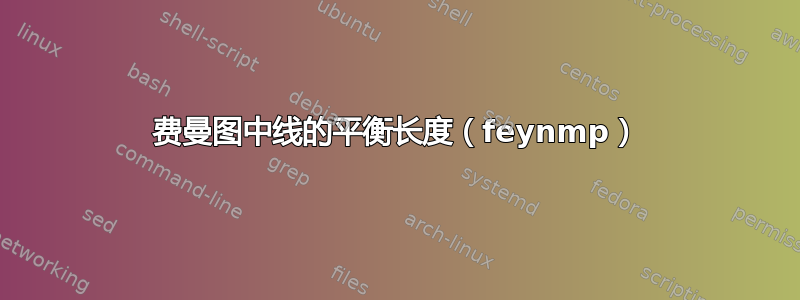
如何才能使费曼图更加对称?我希望“光子/Z 传播子”更短,如果可能的话,在我的图的最右侧留出更多空间,即“超电荷”和“Ws”衰变的地方。
我曾尝试寻找其工作原理phantom,fmffreez但我不知道它能如何帮助我。
% DIRECT PRODUCTION OF CHARGINO/NEUTRALINO
\unitlength=1mm
\begin{figure}
\begin{center}
\begin{fmffile}{wz}
\begin{fmfgraph*}(90,30)
% INCOMING + OUTGOING PARTICLES
\fmfleft{d1,d2,e1,d3,d4,e2,d5,d6} % incoming particles, from below
\fmfright{l1,n,X01,X02,q,qbar} % outgoing particles, from below
\fmf{phantom}{d1,v0}
\fmf{phantom}{d2,v0}
\fmf{phantom}{d3,v0}
\fmf{phantom}{d4,v0}
\fmf{phantom}{d5,v0}
\fmf{phantom}{d6,v0}
\fmf{plain}{e1,v0} % incoming electron
\fmf{plain}{e2,v0} % incoming positron
\fmf{photon,label=$\gamma/Z$}{v0,v1}
% DRAW STUFF
\fmf{photon,label=\textcolor{red} {$\tilde{\chi}_1^{\pm}$},label.side=right,foreground=red}{v1,v2} % chargino, lower
\fmf{photon,label=\textcolor{red}{$\tilde{\chi}_1^{\pm}$},label.side=left,foreground=red}{v1,v3} % chargino, upper
\fmf{photon,label=$W^{\pm}$,label.side=right,label.dist=0.3}{v2,v4} % lower W
\fmf{photon,label=$W^{\pm}$,label.side=left,label.dist=0.2}{v3,v5} % upper W
% decay of upper W
\fmf{plain}{l1,v4,n}
% decay of lower W
\fmf{plain}{q,v5,qbar}
% neutralinos in final state
\fmf{photon,foreground=red}{v2,X01} % upper
\fmf{photon,foreground=red}{v3,X02} % lower
% additional lines for SUSY particles
\fmf{plain,foreground=red}{v3,X02}
\fmf{plain,foreground=red}{v1,v3}
\fmf{plain,foreground=red}{v1,v2}
\fmf{plain,foreground=red}{v2,X01}
% LABELLING
\fmflabel{$e^+$}{e2} % incoming proton (first, from top)
\fmflabel{$e^-$}{e1} % incoming proton (second)
\fmflabel{$\bar{q}$}{qbar} % lepton in final state (first) in Z decay
\fmflabel{$q$}{q} % lepton in final state (second) in Z decay
\fmflabel{$\nu$}{n} % neutralino in final state from W decay
\fmflabel{$\ell^{\pm}$}{l1} % lepton in final state from W decay
\fmflabel{\textcolor{red}{$\tilde{\chi}_1^0$}}{X01} % final state neutralino
\fmflabel{\textcolor{red}{$\tilde{\chi}_1^0$}}{X02} % final state neutralino
\end{fmfgraph*}
\end{fmffile}
\end{center}
\hspace{1cm}
\end{figure}
答案1
答案2
尽管您提到使用feynmf/feynmp,但我会提供使用另一个包的答案:钛钾费曼(加拿大运输安全局)。如果您需要使用,请不要觉得有义务接受这个答案feynmf/feynmp。
使用默认的底层算法放置所有顶点,可以这样做:
\feynmandiagram [horizontal=z1 to z2] {
%% Incoming electrons
e1 [particle=\(e^{-}\)]
-- [fermion] z1
-- [fermion] e2 [particle=\(e^{+}\)],
%% gamma/Z propagator
z1 -- [boson, edge label=\(\gamma / Z\)] z2,
%% Supersymmetric particles
{[edges={plain, boson}]
z2 -- [edge label'=\(\tilde \chi_{1}^{\pm}\)] x1
-- x3 [particle=\(\tilde \chi_{1}^{0}\)],
z2 -- [edge label=\(\tilde \chi_{1}^{\pm}\)] x2
-- x4 [particle=\(\tilde \chi_{1}^{0}\)],
},
%% We don't want the \chi to be too far apart
x1 -- [draw=none] x2,
%% W decaying hadronically
x1 -- [boson, edge label'=\(W^{\pm}\)] w1,
q11 [particle=\(\overline q\)] -- [fermion] w1 -- [fermion] q12 [particle=\(q\)],
x2 -- [boson, edge label=\(W^{\pm}\)] w2,
q21 [particle=\(\overline q\)] -- [fermion] w2 -- [fermion] q22 [particle=\(q\)],
%% Finally, the algorithms wants to fan out the particles as much as possible,
%% so to counter that we tie them together
{[edges={draw=none}]
q11 -- q12 -- x3 -- x4 -- q21 -- q22,
},
};
这可能适合你,但如果你想要更精细的控制,那么你必须使用手动或相对放置顶点。代码变得有点复杂,但并不难以管理:
\begin{tikzpicture}
\begin{feynman}
%% e e -> Z
\vertex (z1);
\vertex [above left=1.5cm and 1cm of z1] (e1) {\(e^{-}\)};
\vertex [below left=1.5cm and 1cm of z1] (e2) {\(e^{+}\)};
\vertex [right=2cm of z1] (z2);
%% Z -> X X
\vertex [above right=1cm of z2] (x1);
\vertex [below right=1cm of z2] (x2);
%% We now add the decays of the supersymmetric particles
\vertex [right=2cm of x1] (x3) {\(\tilde \chi_{1}^{0}\)};
\vertex [above right=1cm of x1] (w1);
\vertex [right=1cm of w1] (q11) {\(\overline q\)};
\vertex [above right=0.5cm and 1cm of w1] (q12) {\(q\)};
%% Repeat with the second particle
\vertex [right=2cm of x2] (x4) {\(\tilde \chi_{1}^{0}\)};
\vertex [below right=1cm of x2] (w2);
\vertex [right=1cm of w2] (q21) {\(\overline q\)};
\vertex [below right=0.5cm and 1cm of w2] (q22) {\(q\)};
%% Now connect the dots (literally)
\diagram* {
(e1) -- [fermion] (z1) -- [fermion] (e2),
(z1) -- [boson, edge label=\(\gamma / Z\)] (z2),
{[edges={plain, boson}]
(z2) -- [edge label=\(\tilde \chi_{1}^{\pm}\)] (x1) -- (x3),
(z2) -- [edge label'=\(\tilde \chi_{1}^{\pm}\)] (x2) -- (x4),
},
(x1) -- [boson, edge label=\(W^{\pm}\)] (w1),
(x2) -- [boson, edge label'=\(W^{\pm}\)] (w2),
(q11) -- [fermion] (w1) -- [fermion] (q12),
(q21) -- [fermion] (w2) -- [fermion] (q22),
};
\end{feynman}
\end{tikzpicture}
对于每个代码,都包含在:
\documentclass[tikz]{standalone}
\usepackage[compat=1.1.0]{tikz-feynman}
\begin{document}
%% <code above>
\end{document}






